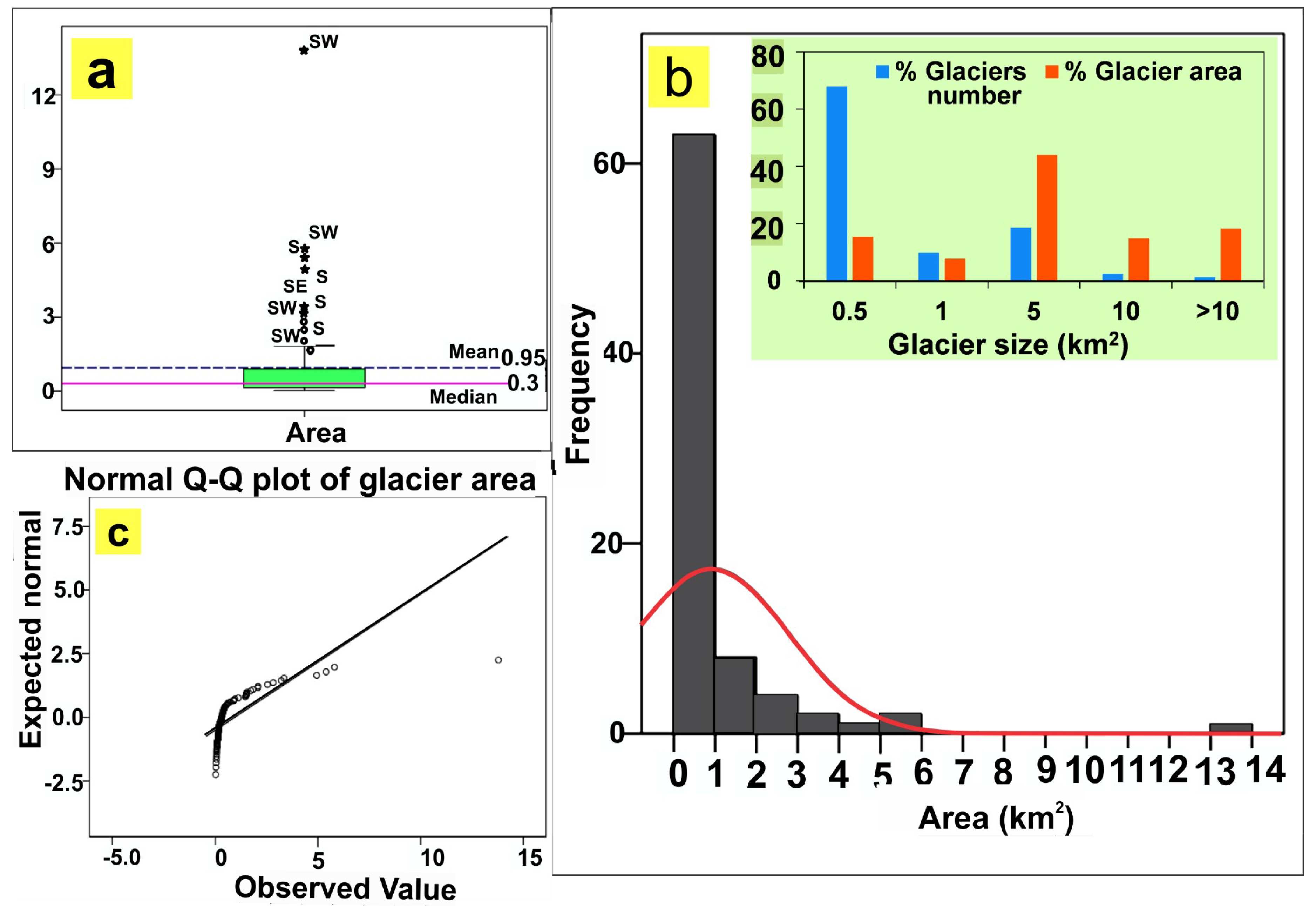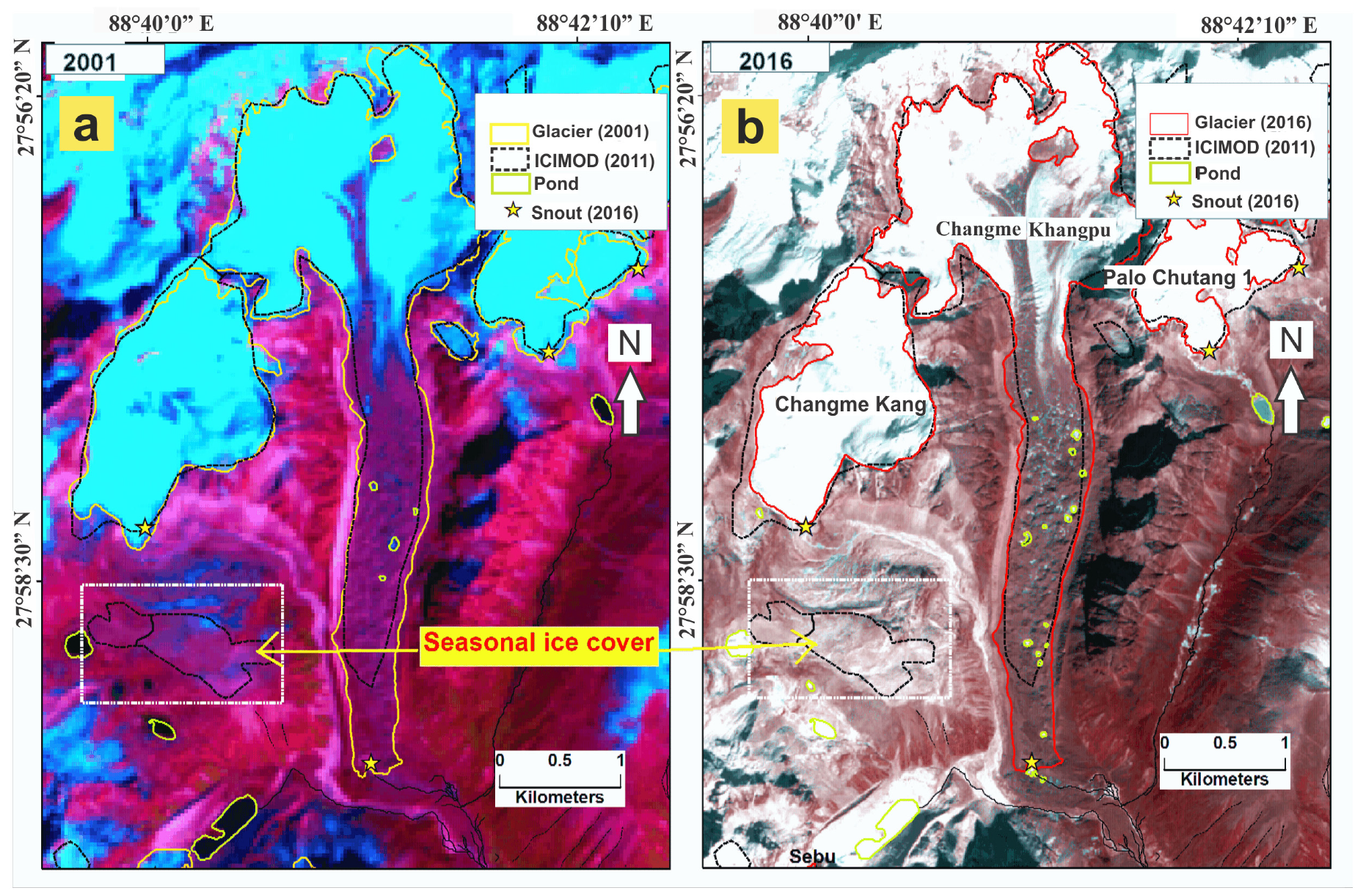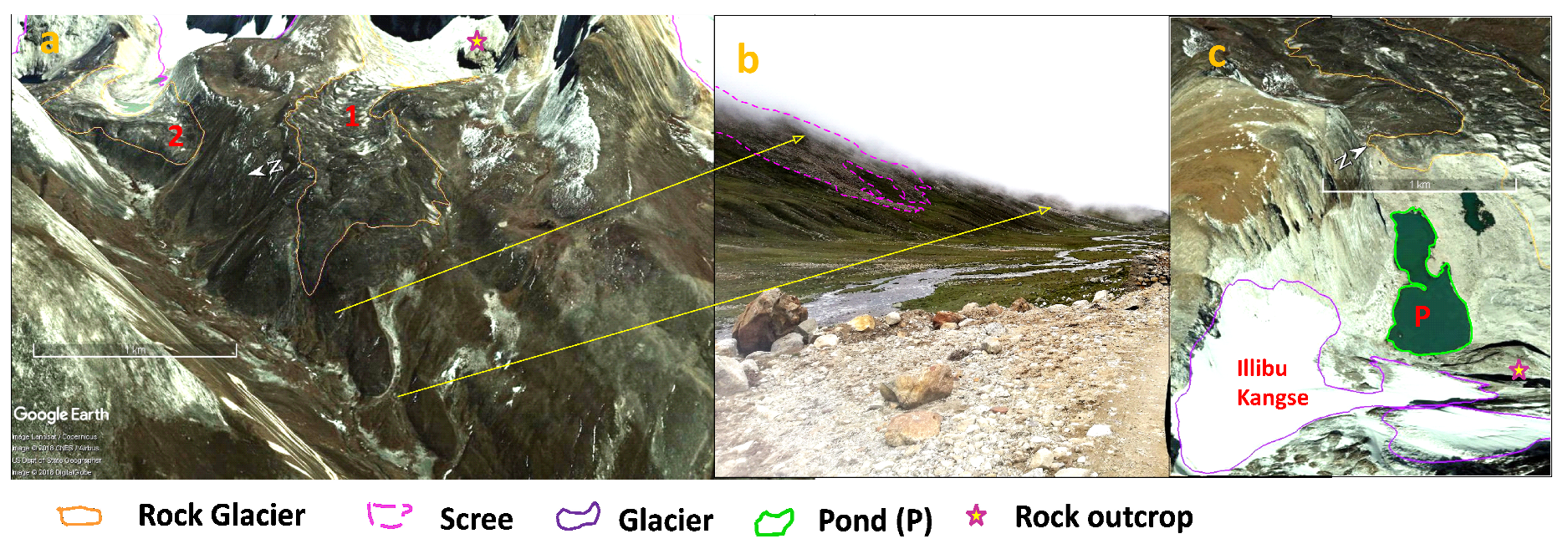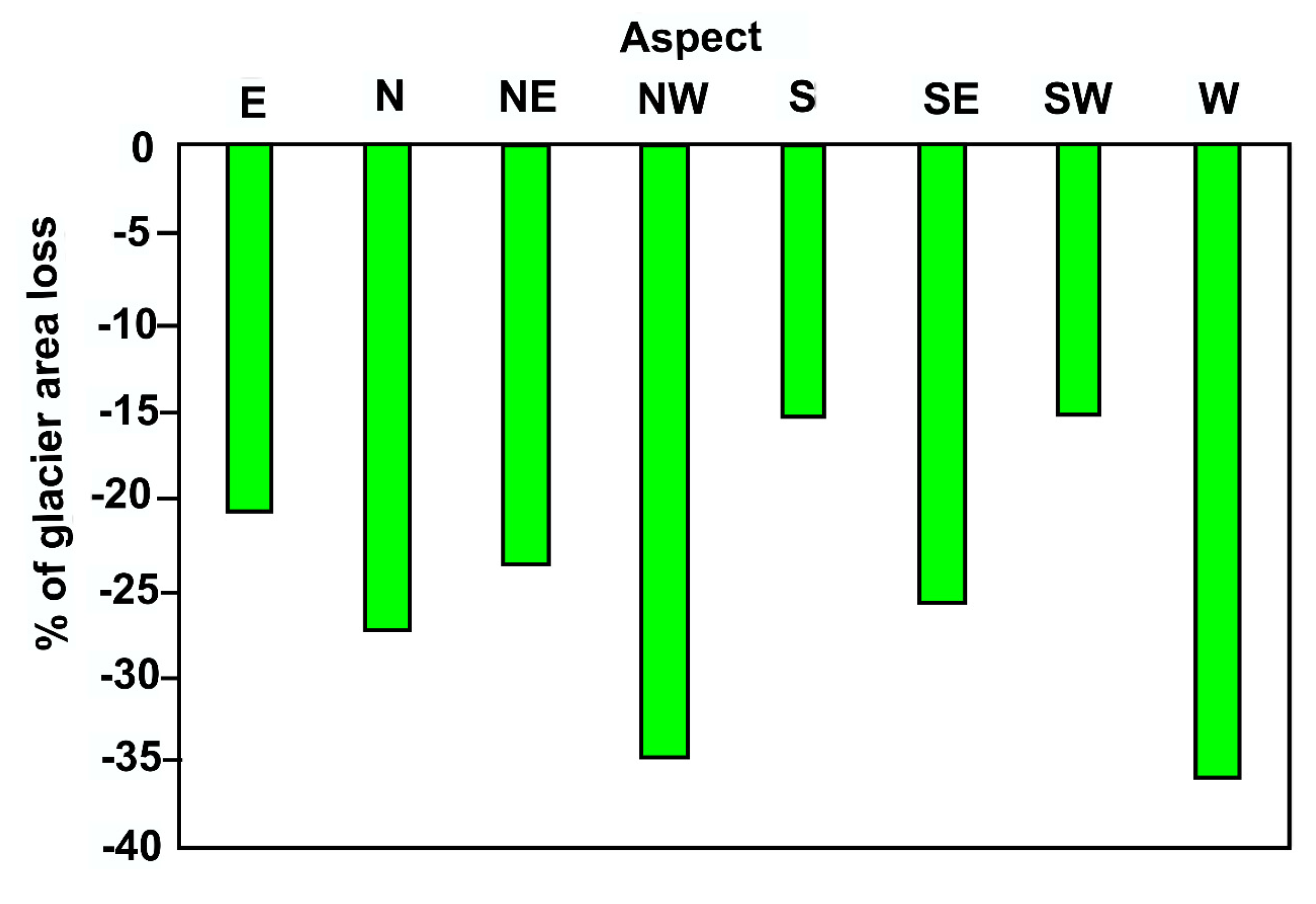Glacier Dynamics in Changme Khangpu Basin, Sikkim Himalaya, India, between 1975 and 2016
Abstract
:1. Introduction
2. Regional Setting
3. Data Source
4. Methodology
4.1. Pre-Processing and the Rectification of Satellite Images
- The first step of the MCT was based on radiometric correction of Landsat sensor images by converting the digital number (DN) values of the bands into a common meaningful physical unit (i.e., top of atmospheric or TOA reflectance) [18]. The algorithm provided by NASA (2009) (https://landsat.gsfc.nasa.gov/wp-content/uploads/2016/08/Landsat7_Handbook.pdf) [24] and (2015) (https://www.greenpolicy360.net/mw/images/Landsat8DataUsersHandbook.pdf) [25] were used for conversion of TM, ETM+ and LANDSAT 8 sensor images respectively. The DN values of Sentinel-2A (MSI) bands were also converted into surface reflectance values that have been further used for the manual digitization of glaciers.
- Panchromatic sharpening (Pan-sharpening) is a technique that combines the high-resolution panchromatic data with medium-resolution multispectral data that create a multispectral image with higher-resolution features. The Pansharpening of 2001 (ETM+) and 2014 (OLI-TIRS) images help in enhancing spatial resolution of multispectral bands (up to 15 m). It was aimed at clear visualization of the glacier termini, glacier boundary, and morphology [8]. The Pan-sharpened bands of LANDSAT series have proved to be a good base map for the rectification of Corona and Hexagon images [8,26].
- The reduction of the distortion pattern towards the edges of the declassified KH-9 images is a necessary requirement of image pre-processing. In this regard, KH-9 images were co-registered with the Pan-sharpened band of LANDSAT 8. The KH-9 images have a complex geometry and large size (2 GB). Therefore, 7 subsets of the KH-9 images for the entire CKB were generated and 150 to 200 common points for each subset were identified in the co-registration process. The co-registration technique of KH-9, given by Padmanabha et al. [27] and Surazakov and Aizen [28], was used. The average horizontal shift between the KH-9 and LANDSAT 8 Pan image amounts to 7.51 m (0.94 pixels). The Sentinel-2A images were co-registered with LANDSAT 8 Pan-sharpened bands, where a 11 m (1.08 pixel) horizontal shift was recorded.
4.2. Mapping Glacier Boundary
4.2.1. Normalized Differential Indexing and Band Ratio
4.2.2. Morphometric Parameters
4.2.3. Land Surface Temperature Measurement
4.2.4. Glacier Boundary Delineation and Inventory Map
4.3. Temporal Changes
4.4. Field Measurements and Validation of the Mapping
4.5. Statistical Methods
5. Result and Discussion
5.1. Regional Distribution of Glaciers in the CKB
5.2. The Controlling Topographic Parameters
5.3. Overall Glacial Area Dynamics in the CKB
5.4. Role of Topography on Glacial Area Dynamics
5.4.1. Glacier Size as a Controlling Parameter
5.4.2. Impact of Debris Cover on Glacial Ice Loss
5.4.3. Aspect and Altitude as the Controlling Factors
6. Conclusions
Supplementary Materials
Author Contributions
Funding
Acknowledgments
Conflicts of Interest
References
- Haeberli, W.; Hoelzle, M.; Paul, F.; Zemp, M. Integrated monitoring of mountain glaciers as key indicators of global climate change: the European Alps. Ann. Glaciol. 2007, 46, 150–160. [Google Scholar] [CrossRef] [Green Version]
- Veettil, B.K.; Wang, S. An update on recent glacier changes in Mexico using Sentinel-2A data. Geogr. Ann. Ser. A Phys. Geogr. 2018, 100, 307–318. [Google Scholar] [CrossRef]
- Williams, M.W. The Status of Glaciers in the Hindu Kush – Himalayan Region. Mt. Res. Dev. 2013, 33, 114–115. [Google Scholar] [CrossRef]
- Haireti, A.; Tateishi, R.; Alsaaideh, B.; Gharechelou, S. Multi -criteri a techn nique for mapping of debris- covered and clean- ice glaciers in Shaksgam valley using Landsat TM and ASTER GDEM. J. Mt. Sci 2016, 13, 703–714. [Google Scholar] [CrossRef]
- Bahuguna, I.M.; Rathore, B.P.; Brahmbhatt, R.; Sharma, M.; Dhar, S.; Randhawa, S.S.; Kumar, K.; Romshoo, S.; Shah, R.D.; Ganjoo, R.K.; et al. Are the Himalayan glaciers retreating? Curr. Sci. 2014, 106, 1008–1013. [Google Scholar]
- Qureshi, M.A.; Yi, C.; Xu, X.; Li, Y. Glacier status during the period 1973 e 2014 in the Hunza Basin, Western Karakoram. Quat. Int. 2017, 444, 125–136. [Google Scholar] [CrossRef]
- Raj, K.B.G.; Rao, V.V.N.; Kumar, K.V.; Diwakar, P.G. Alarming recession of glaciers in Bhilangna basin, Garhwal Himalaya, from 1965 to 2014 analysed from Corona and Cartosat data. Geomat. Nat. Hazards Risk 2017, 8, 1424–1439. [Google Scholar] [Green Version]
- Chand, P.; Sharma, M.C. Glacier changes in the Ravi basin, North-Western Himalaya (India) during the last four decades (1971-2010/13). Glob. Planet. Chang. 2015, 135, 133–147. [Google Scholar] [CrossRef]
- Bajracharya, S.R.; Shrestha, B. The Status of Glaciers in the Hindu Kush-Himalayan Region; International Centre for Integrated Mountain Development (ICIMOD): Kathmandu, Nepal, 2011; ISBN 978 92 9115 217. [Google Scholar]
- Dobreva, I.D.; Bishop, M.P.; Bush, A.B.G. Climate-glacier dynamics and topographic forcing in the Karakoram Himalaya: Concepts, issues and research directions. Water 2017, 9, 405. [Google Scholar] [CrossRef]
- Thompson, S.; Benn, D.I.; Mertes, J.; Luckman, A. Stagnation and mass loss on a Himalayan debris-covered glacier: Processes, patterns and rates. J. Glaciol. 2016, 62, 467–485. [Google Scholar] [CrossRef]
- Robson, B.A.; Nuth, C.; Nielsen, P.R.; Girod, L.; Hendrickx, M. Spatial Variability in Patterns of Glacier Change across the Manaslu Range, Central Himalaya. Front. Earth Sci. 2018, 6, 1–19. [Google Scholar] [CrossRef]
- Das, S.; Sharma, M.C. Glacier changes between 1971 and 2016 in the Jankar Chhu Watershed, Lahaul Himalaya, India. J. Glaciol. 2018, 1–16. [Google Scholar] [CrossRef]
- Raina, V.K.; Srivastava, D. Glacier Atlas of India; Geological Survey of India: Bangalore, India, 2008.
- Fujita, K.; Ageta, Y. Effect of summer accumulation on glacier mass balance on the Tibetan Plateau revealed by mass-balance model. J. Glaciol. 2000, 46, 244–252. [Google Scholar] [CrossRef] [Green Version]
- Salerno, F.; Thakuri, S.; Tartari, G.; Nuimura, T.; Sunako, S.; Sakai, A.; Fujita, K. Debris-covered glacier anomaly? Morphological factors controlling changes in the mass balance, surface area, terminus position, and snow line altitude of Himalayan glaciers. Earth Planet. Sci. Lett. 2017, 471, 19–31. [Google Scholar] [CrossRef]
- Thakuri, S.; Salerno, F.; Smiraglia, C.; Bolch, T.; D’Agata, C.; Viviano, G.; Tartari, G. Tracing glacier changes since the 1960s on the south slope of Mt. Everest (central Southern Himalaya) using optical satellite imagery. Cryosphere 2014, 8, 1297–1315. [Google Scholar] [CrossRef] [Green Version]
- Debnath, M.; Syiemlieh, H.J.; Sharma, M.C.; Kumar, R.; Chowdhury, A.; Lal, U. Glacial lake dynamics and lake surface temperature assessment along the Kangchengayo-Pauhunri Massif, Sikkim Himalaya, 1988–2014. Remote Sens. Appl. Soc. Environ. 2018, 9, 26–41. [Google Scholar] [CrossRef]
- Mann, H.B. Nonparametric Tests Against Trend. Econometrica 1945, 13, 245–259. [Google Scholar] [CrossRef]
- Kendall, M.G. Rank Correlation Methods, 4th ed.; Charles Griffin: London, UK, 1975. [Google Scholar]
- Bookhagen, B.; Burbank, D.W. Topography, Relief, and TRMM-derived rainfall variations along the Himalaya. Geophys. Res. Lett. 2006, 33, 17–18. [Google Scholar]
- Chaturvedi, R.K.; Kulkarni, A.V.; Karyakarte, Y.; Govindasamy, B. Glacial mass balance changes in the Karakoram and Himalaya based on CMIP5 multi-model climate projections Glacial mass balance changes in the Karakoram and Himalaya based on CMIP5 multi-model. Clim. Chang. 2014, 123. [Google Scholar] [CrossRef]
- Sakai, A.; Nuimura, T.; Fujita, K.; Takenaka, S.; Nagai, H.; Lamsal, D. Climate regime of Asian glaciers revealed by GAMDAM glacier inventory. Cryosphere 2015, 9, 865–880. [Google Scholar] [CrossRef] [Green Version]
- NASA Landsat 7 science data user’s handbook. Available online: https://landsat.gsfc.nasa.gov/landsat-7-science-data-users-handbook/ (accessed on 25 May 2019).
- USGS Landsat 8 (L8) Data Users Handbook Version 1.0 June 2015. Available online: https://www.usgs.gov/land-resources/nli/landsat/landsat-8-data-users-handbook (accessed on 25 May 2019).
- Usmanova, Z.; Shahgedanova, M.; Severskiy, I.; Nosenko, G.; Kapitsa, V. Assessment of Glacier Area Change in the Tekes River Basin, Central Tien Shan, Kazakhstan Between 1976 and 2013 Using Landsat and KH-9 Imagery. Cryosph. Discuss. 2016, 1–47. [Google Scholar] [CrossRef]
- Padmanabha, E.A.; Shashivardhan, P.; Shashivardhan, P.; Shashivardhan Reddy, P.; Narender, B.; Muralikrishnan, S.; Dadhwal, V.K. Photogrammetric processing of hexagon stereo data for change detection studies. ISPRS Ann. Photogramm. Remote Sens. Spat. Inf. Sci. 2014, II-8, 151–157. [Google Scholar] [CrossRef] [Green Version]
- Surazakov, A.; Aizen, V. Positional accuracy evaluation of declassified Hexagon KH-9 mapping camera imagery. Photogramm. Eng. Remote Sens. 2010, 5, 603–608. [Google Scholar] [CrossRef]
- Bolch, T.; Kamp, U. Glacier Mapping in High Mountains Using DEMs, Landsat and ASTER Data, Proceedings of the 8th International Symposium on High Mountain Remote Sensing Cartography, La Paz, Bolivia, 20–27 March 2005; Kaufmann, V., Sulzer, W., Eds.; Karl Franzens University: Graz, Austria, 2006; pp. 13–24. [Google Scholar]
- Racoviteanu, A.E.; Arnaud, Y.; Williams, M.W.; Ordoñez, J. Decadal changes in glacier parameters in the Cordillera Blanca, Peru, derived from remote sensing. J. Glaciol. 2008, 54, 499–510. [Google Scholar] [CrossRef] [Green Version]
- Racoviteanu, A.E.; Paul, F.; Raup, B.; Khalsa, S.J.S.; Armstrong, R. Challenges and recommendations in mapping of glacier parameters from space: Results of the 2008 global land ice measurements from space (GLIMS) workshop, Boulder, Colorado, USA. Ann. Glaciol. 2010, 50, 53–69. [Google Scholar] [CrossRef]
- Paul, F.; Huggel, C.; Kääb, A. Combining satellite multispectral image data and a digital elevation model for mapping debris-covered glaciers. Remote Sens. Environ. 2004, 89, 510–518. [Google Scholar] [CrossRef]
- Bhambri, R.; Bolch, T.; Chaujar, R.K.; Kulshreshtha, S.C. Glacier changes in the Garhwal Himalaya, India, from 1968 to 2006 based on remote sensing. J. Glaciol. 2011, 57, 543–556. [Google Scholar] [CrossRef] [Green Version]
- Pratibha, S.; Kulkarni, A.V. Decadal change in supraglacial debris cover in Baspa basin, Western Himalaya. Curr. Sci. 2018, 114, 25–30. [Google Scholar] [CrossRef]
- Ka, A.; Bolch, T.; Casey, K.; Heid, T.; Kargel, J.S.; Leonard, G.J.; Paul, F.; Raup, B.H. Glacier mapping and monitoring using multispectral data. Glob. Land Ice Meas. Space 2014, 75–112. [Google Scholar] [CrossRef]
- Casey, K.A.; Kääb, A.; Benn, D.I. Characterization of glacier debris cover via in situ and optical remote sensing methods: a case study in the Khumbu. Cryosph. Discuss. 2011, 5, 499–564. [Google Scholar] [CrossRef]
- Bolch, T.; Buchroithner, M.; Kunert, A.; Kamp, U. Automated Delineation of Debris-Covered Glaciers Based on ASTER Data. In Proceedings of the 27th EARSel Symp, Bozen, Italy, 4–7 June 2007; pp. 403–410. [Google Scholar]
- Alifu, H.; Tateishi, R.; Johnson, B. A new band ratio technique for mapping debris-covered glaciers using Landsat imagery and a digital elevation model. Int. J. Remote Sens. 2015, 36, 2063–2075. [Google Scholar] [CrossRef]
- Gillespie, A. Land Surface Emissivity. In Encyclopedia of Remote Sensing; Njoku, E.G., Ed.; Springer: New York, NY, USA, 2016; pp. 401–402. [Google Scholar]
- Sobrino, J.A.; Jiménez-Muñoz, J.C.; Sòria, G.; Romaguera, M.; Guanter, L.; Moreno, J.; Plaza, A.; Martínez, P. Land surface emissivity retrieval from different VNIR and TIR sensors. IEEE Trans. Geosci. Remote Sens. 2008, 46, 316–327. [Google Scholar] [CrossRef]
- Wang, F.; Qin, Z.; Song, C.; Tu, L.; Karnieli, A.; Zhao, S. An improved mono-window algorithm for land surface temperature retrieval from landsat 8 thermal infrared sensor data. Remote Sens. 2015, 7, 4268–4289. [Google Scholar] [CrossRef]
- Whalley, W.B.; Azizi, F. Rock glaciers and protalus landforms: Analogous forms and ice sources on Earth and Mars. J. Geophys. Res. 2003, 108, 1–17. [Google Scholar] [CrossRef]
- Granshaw, F.D.; Fountain, A.G. Glacier change (1958–1998) in the North Cascades National Park Complex, Washington, USA Frank. J. Glaciol. 2006, 52, 251–256. [Google Scholar] [CrossRef]
- Bolch, T.; Menounos, B.; Wheate, R. Landsat-based inventory of glaciers in western Canada, 1985-2005. Remote Sens. Environ. 2010, 114, 127–137. [Google Scholar] [CrossRef]
- Bolch, T.; Yao, T.; Kang, S.; Buchroithner, M.F.; Scherer, D.; Maussion, F.; Huintjes, E.; Schneider, C. A glacier inventory for the western Nyainqentanglha range and the Nam Co Basin, Tibet, and glacier changes 1976–2009. Cryosphere 2010, 4, 419–433. [Google Scholar] [CrossRef]
- Hall, D.K.; Bayr, K.J.; Schöner, W.; Bindschadler, R.A.; Chien, J.Y.L. Consideration of the errors inherent in mapping historical glacier positions in Austria from the ground and space (1893-2001). Remote Sens. Environ. 2003, 86, 566–577. [Google Scholar] [CrossRef]
- Wang, X.; Chen, H.; Chen, Y. Topography-Related Glacier Area Changes in Central Tianshan from 1989 to 2015 Derived from Landsat Images and ASTER GDEM Data. Water 2018, 10. [Google Scholar] [CrossRef]
- Li, Y.; Li, Y. Topographic and geometric controls on glacier changes in the central Tien Shan, China, since the Little Ice Age. Ann. Glaciol. 2014, 55, 177–186. [Google Scholar] [CrossRef] [Green Version]
- Nagai, H.; Fujita, K.; Nuimura, T.; Sakai, A. Southwest-facing slopes control the formation of debris-covered glaciers in the Bhutan Himalaya. Cryosphere 2013, 7, 1303–1314. [Google Scholar] [CrossRef] [Green Version]
- Brahmbhatt, R.M.; Bahuguna, I.M.; Rathore, B.P.; Kulkarni, A.V.; Shah, R.D.; Rajawat, A.S.; Kargel, J.S. Significance of glacio-morphological factors in glacier retreat: a case study of part of Chenab basin, Himalaya. J. Mt. Sci. 2017, 14, 128–141. [Google Scholar] [CrossRef]
- Bhattacharyya, A.; Chaudhary, V. Late-Summer Temperature Reconstruction of the Eastern Himalayan Region Based on Tree-Ring Data of Abies densa. Arctic, Antarct. Alp. Res. 2006, 35, 196–202. [Google Scholar] [CrossRef]
- Yadava, A.K.; Yadav, R.R.; Misra, K.G.; Singh, J. Tree ring evidence of late summer warming in Sikkim, northeast India. Quat. Int. 2015, 371, 175–180. [Google Scholar] [CrossRef]
- Borgaonkar, H.P.; Gandhi, N.; Ram, S.; Krishnan, R. Tree-ring reconstruction of late summer temperatures in northern Sikkim (eastern Himalayas). Palaeogeogr. Palaeoclimatol. Palaeoecol. 2018, 504, 125–135. [Google Scholar] [CrossRef]
- Ojha, S.; Fujita, K.; Sakai, A.; Nagai, H.; Lamsal, D. Topographic controls on the debris-cover extent of glaciers in the Eastern Himalayas: Regional analysis using a novel high-resolution glacier inventory. Quat. Int. 2017, 455, 82–92. [Google Scholar] [CrossRef]
- Bolch, T.; Kulkarni, A.; Kääb, A.; Huggel, C.; Paul, F.; Cogley, J.G.; Fujita, K.; Scheel, M.; Bajracharya, S.; Stoffel, M. The State and Fate of Himalayan Glaciers. Science 2012, 336, 310–314. [Google Scholar] [CrossRef] [Green Version]
- Kulkarni, A.V.; Rathore, B.P.; Singh, S.K.; Bahuguna, I.M. Understanding changes in the Himalayan cryosphere using remote sensing techniques. Int. J. Remote Sens. 2011, 32, 601–615. [Google Scholar] [CrossRef]
- Benn, D.I.; Kirkbride, M.P.; Owen, L.A.; Brazier, V. Glaciated Valley Landsystems. In Glacial Landsystems; Evans, D.J.A., Ed.; Hodder Arnold: London, UK, 2005; pp. 372–406. [Google Scholar]
- Benn, D.; Bolch, T.; Hands, K.; Kingdom, U.; Gulley, J.; Luckman, A.; Nicholson, L.I.; Quincey, Q.; Thompson, S.; Toumi, R.; et al. Response of debris-covered glaciers in the Mount Everest region to recent warming, and implications for outburst flood hazards. Earth-Sci. Rev. 2012, 114, 156–174. [Google Scholar] [CrossRef] [Green Version]
- Watson, C.S.; Quincey, D.J.; Carrivick, J.L.; Smith, M.W.; Richardson, R. Heterogeneous water storage and thermal regime of supraglacial ponds on debris-covered glaciers. Earth Surf. Process. Landforms 2018, 43, 229–241. [Google Scholar] [CrossRef]
- Sakai, A.; Takeuchi, N.; Fujita, K.; Nakawo, M. Role of supraglacial ponds in the ablation process of a debris-covered glacier in the Nepal Himalayas. IAHS Publ. 2000, 265, 119–130. [Google Scholar]
- Benn, D.I.; Evans, D.J.A. Glaciers & Glaciation, 2nd ed.; Hodder Education: London, UK, 2010. [Google Scholar]















| Precipitation | Temperature | |||||
|---|---|---|---|---|---|---|
| Season | Kendall’s Tau | Level of Significance | Sen’s Slope (mm a−1) | Kendall’s Tau | Level of Significance | Sen’s Slope (°C a−1) |
| Winter | 0.165 | 0.027 | 0.188 | 0.264 | 0.001 | 0.014 |
| Pre-monsoon | 0.266 | 0.001 | 1.083 | 0.232 | 0.003 | 0.019 |
| Monsoon | 0.001 | 0.498 | 0.010 | 0.381 | <0.0001 | 0.021 |
| Post-monsoon | 0.019 | 0.415 | 0.061 | 0.339 | <0.0001 | 0.027 |
| Satellite Sensors | Acquired Date | Repeat Coverage Interval (Days) | Spatial Resolution |
|---|---|---|---|
| Declassified Hexagon (KH9) | 20 February 1975 | N.A. | 8 m |
| LANDSAT TM | 1 December 1988 | 16 | MS* & TIRS* (30 m) |
| LANDSAT ETM+ | 26 October 2001 | 16 | MS* & TIRS*(30 m); Pan* (15 m) |
| LANDSAT OLI-TIRS | 7 Novermber 2014 | 16 | MS* (30 m); TIRS*(100 m); Pan* (15 m) |
| Sentinel-2A | 6 January 2016 | 5 | 10 m |
| Google Earth Images | 2015–2016 | N.A. | 1.65 to 2.62 m |
| SRTM DEM | 11–22 February 2000 | N.A. | 30 m |
| CRU temperature & Precipitation | 1950–2014 | N.A. | 0.50° × 0.50° |
| Monthly Temperature and Precipitation (India Waterportal) | 1901–2002 | N.A. | In situ |
| Swiss Foundation For Alpine Research’s map of Sikkim Himalaya | 1981 | N.A. | 1:150,000 |
| General Statistics of Glacier Area in 2016 | |||
|---|---|---|---|
| N | 81 | ||
| Skewness | 4.741 | ||
| Std. Error of Skewness | 0.269 | ||
| Kurtosis | 28.453 | ||
| Std. Error of Kurtosis | 0.532 | ||
| Shapiro-Wilk | |||
| Statistic | df | Sig. | |
| Area | 0.476 | 81 | 0.000 |
| Period | % of Area Change | Rate of Change (km2·a−1) | Uncertainty of Rate of Area Change |
|---|---|---|---|
| 1975–2016 | −20.72 (±3.25) | −0.453 | ±0.001 |
| 2001–2016 | −11.84 (±4.51) | −0.665 | ±0.243 |
| 1988–2001 | −3.97 (±8.01) | −0.170 | ±0.536 |
| 1975–1988 | −6.35 (±7.37) | −0.491 | ±0.499 |
| Tot. Glacier Area (1975) | Tot. Glacier Area Change 1975–2016 | % of AC 1975–2016 | Rate of % of AC 1975–2016 | Rate AC 1975–2016 | Rate AC 1975–1988 | Rate AC 1988–2001 | Rate AC 2001–2016 | |
|---|---|---|---|---|---|---|---|---|
| Debris free | 51.451 | −13.032 | −25.329 | −0.618 | −0.318 | −0.244 | −0.149 | −0.528 |
| Maximum Debris covered | 23.887 | −3.685 | −15.426 | −0.376 | −0.090 | −0.136 | −0.016 | −0.114 |
| Partly debris covered | 17.419 | −2.578 | −14.801 | −0.361 | −0.063 | −0.111 | −0.016 | −0.062 |
© 2019 by the authors. Licensee MDPI, Basel, Switzerland. This article is an open access article distributed under the terms and conditions of the Creative Commons Attribution (CC BY) license (http://creativecommons.org/licenses/by/4.0/).
Share and Cite
Debnath, M.; Sharma, M.C.; Syiemlieh, H.J. Glacier Dynamics in Changme Khangpu Basin, Sikkim Himalaya, India, between 1975 and 2016. Geosciences 2019, 9, 259. https://doi.org/10.3390/geosciences9060259
Debnath M, Sharma MC, Syiemlieh HJ. Glacier Dynamics in Changme Khangpu Basin, Sikkim Himalaya, India, between 1975 and 2016. Geosciences. 2019; 9(6):259. https://doi.org/10.3390/geosciences9060259
Chicago/Turabian StyleDebnath, Manasi, Milap Chand Sharma, and Hiambok Jones Syiemlieh. 2019. "Glacier Dynamics in Changme Khangpu Basin, Sikkim Himalaya, India, between 1975 and 2016" Geosciences 9, no. 6: 259. https://doi.org/10.3390/geosciences9060259




